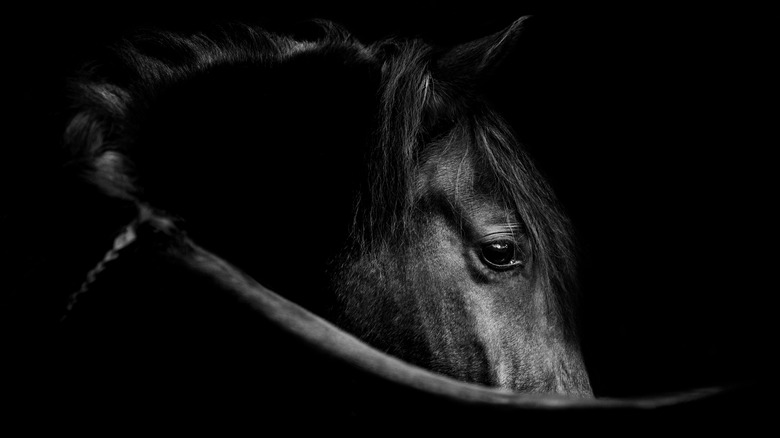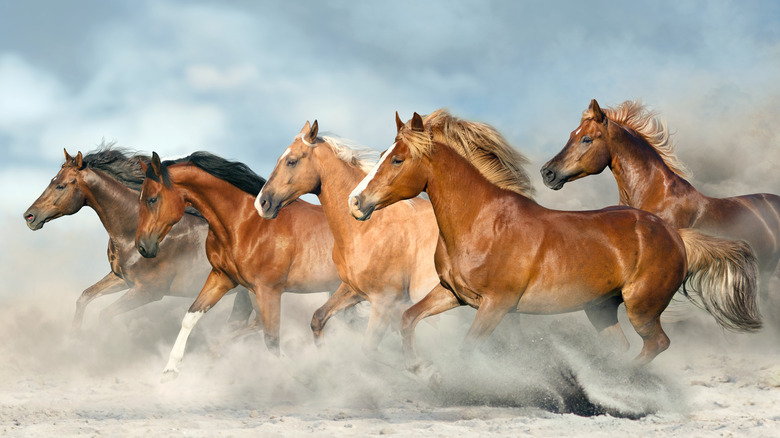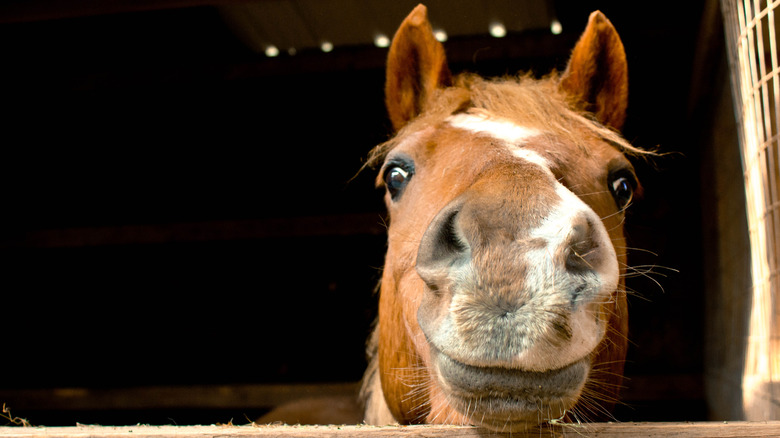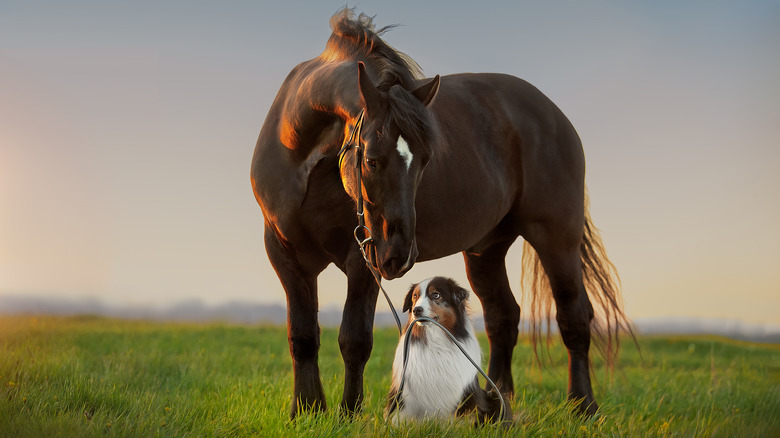How Did People Domesticate Horses?
It's no exaggeration to say that the domestication of animals radically altered, and in a sense totally guided, the development of all of human civilization, going back to that very first brave wolf who circled a fire and napped some meat from an equally brave hunter-gatherer some 27,000 – 40,000 years ago (per New Scientist). Wolves-turned-dogs were the first domesticated animal, by far, and humans were burying them like family members by about 14,200 years ago. To put things into perspective, that's before people started domesticating plants, i.e., developing agriculture.
That epoch – the conversion from hunting and foraging to farming — marked the next step in domestication. No longer did dogs merely protect and help hunt, but goats, sheep, pigs, and eventually cows (all plant-eating herbivores) provided milk, meat, clothing like wool, materials like leather, helped humans plow, and much more. Over the course of thousands of years, starting about 12,000 BCE (per National Geographic), people started living in stationary settlements, and domesticating everything from millet to figs, rice to mangoes. History changed forever because folks stayed put to grow their crops, which guided the development of cities, commerce, eventually kingdoms, empires, technological advancements, economic strata encompassing the rich and poor, country vs. urban cultural evolution, the progress of the arts: practically any and everything that exists — no exaggeration.
And right smack dab in the middle of this timeline came one of transportation's, agriculture's, commerce's, and warfare's biggest game-changers: horses.
Transportation, warfare, and commerce redefined
Think about it for a second: If you want to travel from Boston to New York, how long does it take? In the U.S., people often reckon distance by cars, which clocks in at about 3.5 hours without horrible traffic. Airplanes are much faster, and decent trains are about the same as cars. On foot? You're looking at days. But what about in between our built-in biological speed and a mere 150 years of recent technological developments? This is why horses were so critical to carrying information and people quickly over long distances, without which there could not be vast empires. And as CNN says, it only took about 500 years to go from jumping on the first, fast, sleek, majestic wild horse to building entire chariot cavalcades for use in combat.
It's easy to imagine some bold people, much like those who first overcame their fear of wolves, looking at a pack of running horses and thinking, "Heck, I wish I could go that fast. My feet are tired. Let's get one!" Of course, we don't know exactly how they did it. No early civilizations recorded the precise procedure their ancestors used to wrangle, catch, entrap, tame, and eventually breed animals. And the world's first extant writing system didn't exist until 3,400 – 3,300 BCE in Mesopotamia in the Middle East, as the British Library recounts. The shared ancestor of domesticated horses didn't show up until over 1,000 years later, from around 2,200 BCE.
The Steppe Hypothesis steered anew
Dating the domestication of horses is tricky because their bodies haven't changed much since domestication (we're not talking about breeds). Goats, sheep, cows, pigs, dogs, and cats typically got smaller when domesticated, except in the case of, say, mini-bears like Bernese Mountain Dogs bred for very specific tasks. Horses, though, had to stay large in order to perform their primary function of, you know, carrying human bodies. Or, like monstrously muscular draft horses described on Deep Hollow Ranch, they performed work like pulling plows. So, we can't be sure if the remains of horses are wild or domesticated without further material or DNA evidence. Plus, horses traveled, were sold, and died over long distances, rather than stayed huddled near a farm or homestead.
As CNN says, researchers have often had to work off "indirect evidence" to trace the domestication of horses, including tooth damage that suggests the use of bridles, or symbolism found across cultures. For a long time, per National Geographic, the "Steppe Hypothesis" reigned supreme, which suggested that at some point about 3,000 BCE people between the Black and Caspian Seas known as the Yamnaya first rode off from their lands and brought horses and trade with them. Critically, they also brought their language, Indo-European, the progenitor of hundreds of languages, described on World History, including Sanskrit, Greek, Welsh, Portuguese, Polish, Norwegian, and yes, English. Horses yielded the world's first globalized mass exodus.
The location, though, we got wrong. It all started in Russia.
Genetic testing traced back to southern Russia
As National Geographic explains, researchers tested 273 separate equine genomes across Europe and Central Asia to pinpoint a region in southern Russia near the intersection of the Volga and Don Rivers as the origin of "Equus caballus," domesticated horses. Granted, this is not too, too far away from the Black and Caspian Seas, but now we have data to confirm long-held deductions. The rest of the horse story, including humanity's first global migration and the radical overhauling of cultures, remains the same. The change to human society happened "almost overnight," study leader Ludovic Orlando said, molecular archaeologist at University Paul Sabatier in Toulouse, France. It wasn't something gradual over thousands of years, like the domestication of wheat or cows.
It's likely that the domestication of horses started during the Bronze Age, from about 3,000 BCE. All modern, domesticated horses date back to those horses at the Volga and Don rivers from 2,700 to 2,200 BCE. This makes sense because it would have taken some time for our ancestors to figure out the whole "who do I catch and control this far faster and stronger animal" thing.
A big piece of the puzzle came from the dramatic shrinkage of horse diversity as compared with a dramatic rise in horse numbers across Europe and Asia. People began breeding horses for specific traits like stronger backs, calmer dispositions, and so on. Ever since then, our own genetic lineage and horses' has stayed intertwined.



